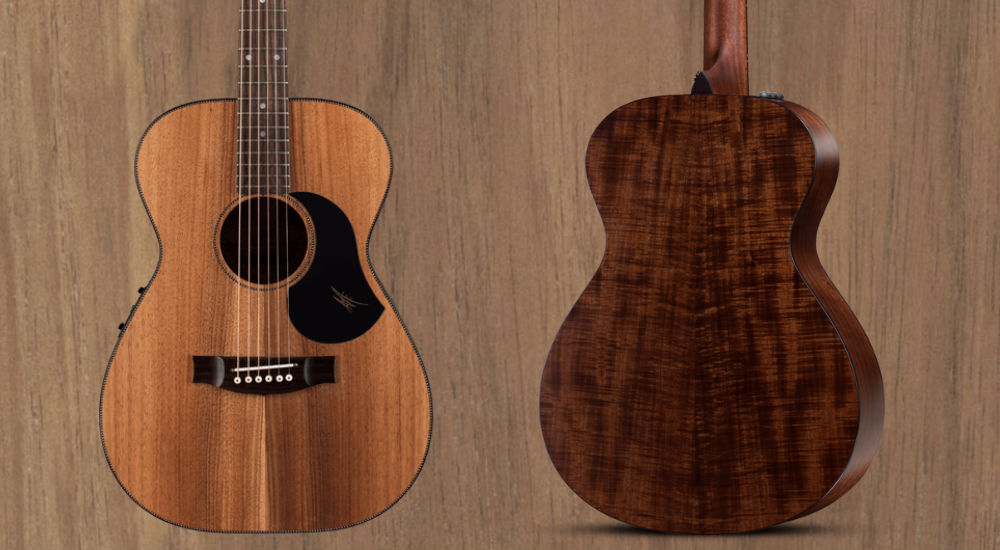It goes without saying that Australia is home to quite an abundance of unique flora and fauna.
However, there’s one important aspect of Australia’s ecology that’s particularly pertinent to us musical folk, and that’s our wide range of native tonewood. While we mightn’t possess an endemic species such as spruce, rosewood or mahogany, several of our native timbers have come to be known as a wonderful alternative to many of those world-renowned species used as tonewoods overseas thanks to the likes of local manufacturers like Maton and Cole Clark.
Read up on all the latest features and columns here.
Better yet, the most popular Australian species used for tonewood also tend to be a much more sustainable and eco-friendly option than overseas variants, with the likes of Blackwood, Queensland Maple and Bunya bearing their own unique tonal and aesthetic characteristics that have seen them become popular with some of the biggest domestic and international manufacturers today.
Tonewood
Today, we’re turning the focus to some of the most popular and unique native timbers found around Australia in order to better understand how and why these species have come to be synonymous with music manufacturing both at home and abroad.
Australian Tonewoods
Australian Blackwood
One of the most prevalent tonewoods used by Australian guitar manufacturers today, Blackwood (Acacia Melanoxylon) is an incredibly decorative timber found in Australia’s south-eastern regions, with growth ranging from South Australia and Tasmania all the way up into Queensland. Sometimes referred to as Tasmanian Blackwood or mudgerabah, Blackwood was first sourced by Australia’s Indigenous populations centuries ago to make spear-throwers and shields, and is commonly used today to create furniture, cabinets and even boats. The majority of Blackwood sourced for guitar manufacturers in Australia comes from plantations in the Otway Ranges in Victoria or further down into Tasmania.
Blackwood is said to display a natural ‘fiddleback’ look and can often feature bold figuring, making it an increasingly viable alternative timber with many manufacturers. It produces a warm, full tone and is exceptionally rich in the midrange, with many players and makers comparing Blackwood’s tonal qualities to that of koa. Blackwood is also known for being a rather stiff timber that’s perfectly suited for percussive playing, and is renowned for handling climate extremes better than many other Australian tonewoods.
For over 40 years, renowned local manufacturers Maton have championed the use of Blackwood as an alternative tonewood. Several of their most prominent models feature Blackwood sides, backs or necks, and the company even introduced an all Blackwood range into their lineup back in 2017 to huge acclaim from players. Taylor and Cole Clark have also made use of Blackwood over the years, with the latter using it frequently for their Fat Lady and Angel models in conjunction with Bunya or even just as a pure Blackwood model to get the most out of its warm, rich and percussive tone.
Bunya
A striking Australian native, Bunya (Araucaria bidwillii) is best known for its bizarre appearance and large height, as well as its prickly leaves and whopping big cones that can weigh up to 10 kilograms. While commonly known as Bunya Pine due to its appearance and accompanying cones, the Bunya is actually part of the Araucaria genus, and is a relative of the monkey puzzle tree found in South America.
These trees are typically found in natural growth regions regions in south-east and northern Queensland, although natural growth was once far more widespread. Historically, the Bunya holds great significance to various Indigenous populations around Queensland and New South Wales, with a multitude of tribes using the harvest of the pine cones to feast on the Bunya nut and celebrate, trade and negotiate with one another.
Characteristically, Bunya is known for its fine texture and straight, tightened grain, with many examples featuring faint growth rings for a distinctive appearance. It’s renowned for bearing a strong, evocative tone with plenty of volume that’s perfect for soundboards, and projects an incredibly strong midrange that’s suited for fingerpickers and strummers alike. Many local manufacturers tend to favour Bunya as an alternative to spruce tops due to its similar aesthetic appearance, as well as it nature as a sustainable timber, reaching maturity in 80 years as opposed to the 300 years it takes for spruce to reach its prime.
Maton were among the first manufacturers in the world to use Bunya for soundboards back in the 1990s, with other local builders quickly following suit and subsequently spreading its reputation around the world. Bunya is considered by many acoustic fanatics to be the signature sound of Cole Clark guitars, and many of the manufacturers finest models make use of the coveted tonewood, particularly due to how good it sounds when amplified in a live scenario.
Queensland Maple
Queensland Maple (Flindersia brayleyana) is used in almost every single Maton acoustic guitar as a back, neck, side or internal tonewood, and is also the second biggest selling tonewood from Cole Clark. Queensland Maple grows naturally as a rainforest hardwood in regions of northern Queensland and parts of Papua New Guinea, with attempts to grow it in plantations usually ending in failure. Contrary to the name, Queensland Maple also shares no similarities or relation with maple from the United States.
Over time, Queensland Maple has come to be renowned for being a strong, light and extremely well-balanced tonewood, with an evenly dispersed frequency response that makes it a sustainable, natively grown alternative to mahogany. It’s noted for having a neutral tone, and is suitable for amplification, making it a choice pick for players in need of an acoustic guitar to conquer the stage with.
A close relative of Queensland Maple that also sees a lot of use with local luthiers is Queensland Maple Silkwood (Flindersia pimenteliana), which grows in similar regions between the Daintree and Rockingham Bay in Queensland. It’s extremely similar to Queensland Maple, but features a more pronounced bottom end, and is perfect for players who need an enhanced bass response from their acoustic guitar.
Queensland Walnut
With an eye-catching visual appearance similar to that of American Walnut, Queensland Walnut (Endiandra palmerstronii) is a large rainforest tree found only in the coastal tablelands of North Queensland. While commercial availability is limited due to the World Heritage listed status of many of the areas where it tends to be found, Queensland Walnut is noted for its hard, dense characteristics, making it a great fit for use as a side and back tonewood on acoustic guitars. Tonally, Queensland Walnut delivers a full-bodied midrange and bass response as well as a crystal clear top-end, with Maton using it as a laminate for their 325 and 425 series.
Other than being used with guitars, Queensland Walnut is also an extremely desirable wood for drum manufacturing, with manufacturers like Dunnett and Metro Drums using it for snare drums for an exceptional aesthetic and tone.
Huon Pine
A native Tasmanian timber, Huon Pine (Lagarostrobos franklinii) is considered to be one of the oldest species of trees in Australia, with a stand of trees found on Mount Read estimated to be over 10,500 years old. Nowadays, Huon is a highly protected species, with most of the timber used today coming from salvaged or reclaimed stocks; Cole Clark’s supply, for example, was recovered from a lake in Tasmania that flooded in 1972. Similar to that of the Bunya, the Huon isn’t a true pine, and is actually the sole member of the lagarostrobos genus in the broader podocarp family.
Given how strictly protected it is, Huon Pine isn’t as commonly used as a tonewood as some of Australia’s other natives, but is prized by luthiers for its golden appearance, fine grain and natural oils that prevent rotting. Tonally, Huon is highly regarded for its rich overtones and a deep, hefty sustain, and works particularly well for making smaller bodied acoustic guitars sing like a dreadnaught.
Tasmanian Myrtle
Tasmanian Myrtle (Nothofagus cunninghamii) seems to be another tonewood favoured by several custom shops around the world, with Taylor and Cole Clark offering this native timber as an option for the backs and sides of some bespoke models.
Blackheart Sassafras
Another native to Tasmania, Blackheart Sassafras (Atherosperma moschatum) is a rather illustrious timber renowned for its light weight and soft texture, with its dark striping being caused by an infectious staining fungi in the heartwood of the tree. It’s best suited for use as a side and back tonewood, with many luthiers putting the tonal characteristics of the timber somewhere between that of walnut and maple.
Due to the limited supply of timber available, Blackheart Sassafras tends to be used sparingly by many luthiers; however, there’s a number of gorgeous custom shop Taylor acoustic guitars which have made use of Blackheart Sassafras and are considered by many as a highly desirable investment.
Mountain Ash
Sometimes known as Swamp Gum or Stringy Gum, Mountain Ash (Eucalyptus regnans) is an incredibly tall tree found in areas of Tasmania and Victoria, and was frequently used for newsprint in the 20th century. Highly regarded for its balanced tone and occasionally bearing a striking figured appearance, Mountain Ash is used by manufacturers like Fenech Guitars, and is often favoured by electric guitar makers as an alternative to a traditional maple cap.
Southern Silky Oak
Endemic to Australia’s eastern coast, the Southern Silky Oak (Grevillea robusta) is a fast-growing evergreen that’s noted for its balance and beautiful aesthetic appearance. Also known as Australian Silver Oak, this timber is favoured by manufacturers such as Cole Clark and Larivee as a highly figured tonewood used for backs and sides.
Northern Silky Oak
While not within the same genus, the Northern Silky Oak (Cardwellia sublimis) shares similar qualities to the Southern Silky Oak, yet confusingly, neither tree is considered to be a true oak. As the name suggests, Northern Silky Oak is native to Queensland and is typically found between Cairns and Townsville, and is noted for its wonderful grain structure and tap tone.
River She-Oak
Also known as River Oak, River She-Oak (Casuarina cunninghamiana) grows natively in the Northern Territory, Queensland and New South Wales, and is considered to be a sustainable timber by Australian luthiers. River She-Oak is widely recognised for its role in preventing soil erosion along riverbanks due to its ability to cope with wet and dry soils, and is favoured domestically as a screening plant to stop nosy neighbours peeking over the fence.
However, what’s truly special about River She-Oak is how suitable it is for use as a material for fretboards due to its density and straight grain. Described as sitting somewhere between the tone of ebony and rosewood, River She-Oak has become Cole Clark’s main fretboard timber as of 2018, with many other luthiers also singing its praises on forums online.
Mulga
A shrub native to the Australian outback, Mulga (Acacia aneura) is an incredibly tough, hefty hardwood commonly used as a tonewood for bridges and fretboards. Also known as Desert Acacia, Mulga is considered synonymous with many Maton models, and is noted for having a bell-like tone when tapped as a tonewood for fretboards.
Gidgee
Another outback wattle found in semi-arid areas of Australia, Gidgee (Acacia cambagei) is another coveted hardwood used for fretboards or bridges, with Maton using it as a bridge tonewood from time to time on select models. It’s also known as Purple Gidgee or occasionally Stinking Wattle, due to its pungent odour that’s often compared to boiling cabbage – however, musicians tend to be a sweaty bunch anyway, so that shouldn’t put you off it at all.
Read more about Maton’s history specifically, here.







